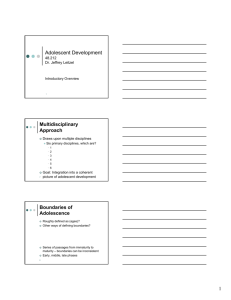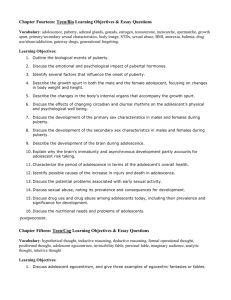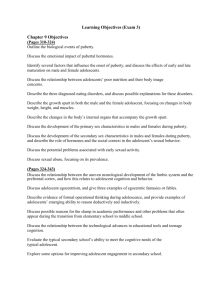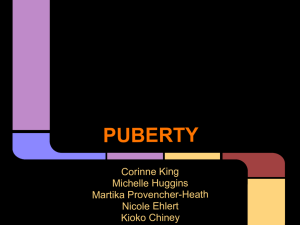Adolescence: Biosocial Development
advertisement
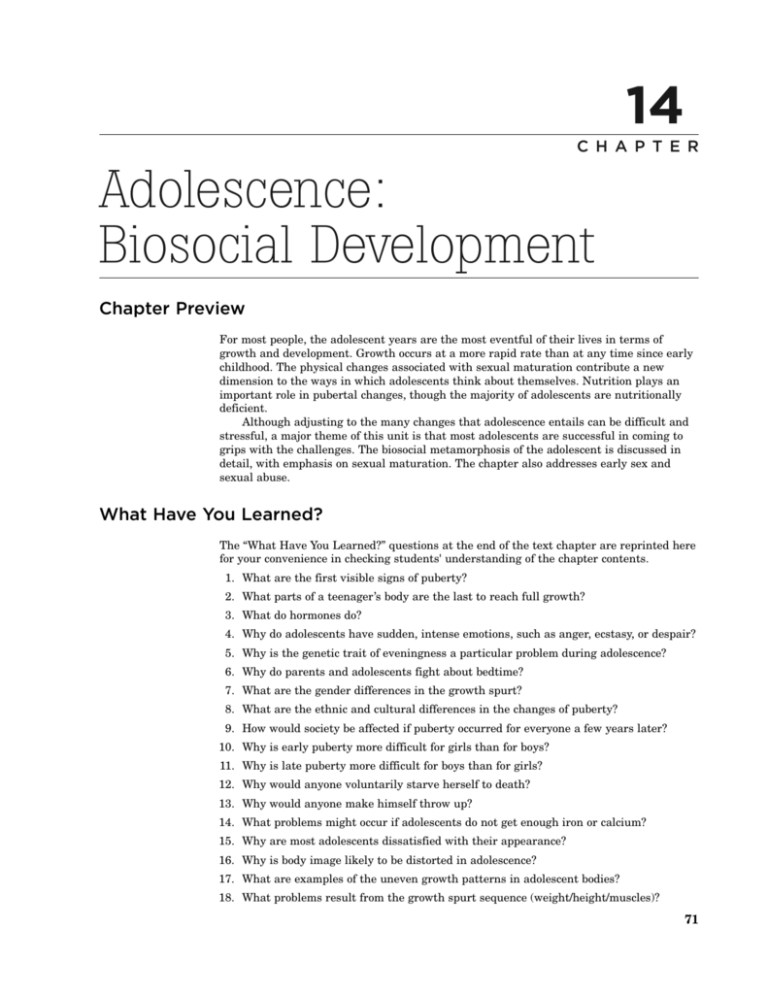
14 C H A P T E R Adolescence: Biosocial Development Chapter Preview For most people, the adolescent years are the most eventful of their lives in terms of growth and development. Growth occurs at a more rapid rate than at any time since early childhood. The physical changes associated with sexual maturation contribute a new dimension to the ways in which adolescents think about themselves. Nutrition plays an important role in pubertal changes, though the majority of adolescents are nutritionally deficient. Although adjusting to the many changes that adolescence entails can be difficult and stressful, a major theme of this unit is that most adolescents are successful in coming to grips with the challenges. The biosocial metamorphosis of the adolescent is discussed in detail, with emphasis on sexual maturation. The chapter also addresses early sex and sexual abuse. What Have You Learned? The “What Have You Learned?” questions at the end of the text chapter are reprinted here for your convenience in checking students' understanding of the chapter contents. 1. What are the first visible signs of puberty? 2. What parts of a teenager’s body are the last to reach full growth? 3. What do hormones do? 4. Why do adolescents have sudden, intense emotions, such as anger, ecstasy, or despair? 5. Why is the genetic trait of eveningness a particular problem during adolescence? 6. Why do parents and adolescents fight about bedtime? 7. What are the gender differences in the growth spurt? 8. What are the ethnic and cultural differences in the changes of puberty? 9. How would society be affected if puberty occurred for everyone a few years later? 10. Why is early puberty more difficult for girls than for boys? 11. Why is late puberty more difficult for boys than for girls? 12. Why would anyone voluntarily starve herself to death? 13. Why would anyone make himself throw up? 14. What problems might occur if adolescents do not get enough iron or calcium? 15. Why are most adolescents dissatisfied with their appearance? 16. Why is body image likely to be distorted in adolescence? 17. What are examples of the uneven growth patterns in adolescent bodies? 18. What problems result from the growth spurt sequence (weight/height/muscles)? 71 72 Chapter 14 Adolescence: Biosocial Development 19. How do religion and culture affect adolescent sexual activity? 20. Among sexually active people, why do adolescents have more STIs than adults? 21. What are positive changes in adolescent sexuality over the past five decades? 22. Why is adolescent sexuality more hazardous now than it was five decades ago? 23. Why is it harmful for a young adolescent and an adult to have sex? 24. How might the timing of maturation of parts of the adolescent brain create problems? 25. In what ways is adolescent brain functioning better than adult brain functioning? Chapter Guide ➤ “On Your Own” Activities: Developmental Fact or Myth? Portfolio Assignment ➤ AV: The Journey Through the Life Span, Program 6: Adolescence; Transitions Throughout the Life Span, Program 14: Explosions; Adolescence; Adolescent Development; Adolescence: The Winds of Change; Teens: What Makes Them Tick?; Teenage Mind and Body ➤ Classroom Activities: Introducing Adolescents, the Risk Takers—Especially in the United States; Using Technology to Introduce Biosocial Development During Adolescence; Empathizing with Adolescents; Using “Radio Diaries” to Study Adolescent Development; The “Storm and Stress” View of Adolescence ➤ Observational Activity: Adolescence Now and Then I. Puberty Begins Instructional Objective: To describe the biological changes that trigger and accompany puberty, and to discuss adolescents’ emotional responses to these changes. ➤ AV: Adolescence: Physical Growth and Development; Adolescent Physical Development; Puberty; Explosions: Biosocial Development During Adolescence ➤ Teaching Tip: Learning to Talk About Sensitive Pubertal Topics ➤ Critical Thinking Activity: Early and Late Maturation 1. The major physical changes of puberty generally occur in the same sequence and are complete four years after they have begun. 2. The current average age of menarche is about 12 years 8 months. Boys experience spermarche, on average, at just under age 13. 3. Puberty begins when a biochemical signal from the hypothalamus stimulates hormone production in the pituitary, which, in turn, triggers hormone production by the adrenal glands. This route is called the HPA axis. Another route, called the HPG axis, affects the body’s entire shape and functioning. Through this route the pituitary activates the gonads (sex glands). 4. The major hormone of puberty is GnRH (gonadotropin-releasing hormone), which causes the gonads to enlarge and to dramatically increase their production of testosterone (especially in boys) and estradiol (especially in girls). Emotional surges and sexual urges usually do increase in adolescence. Although hormones affect brain and body, behavior also plays a role. Thoughts cause physiological and neurological processes, as well as result from them. 5. Brain activity affects body rhythms. Puberty alters biorhythms, which are affected by brain rhythms. All creatures have a daily day–night cycle called circadian rhythm. Hormones and other body chemicals create changes in rhythms, which include when teenagers need the most sleep. Adolescents typically do not get enough sleep to meet their developmental needs. 6. Physical growth during puberty usually begins sometime between ages 8 and 13. The variation is related to gender, genetic inheritance, body fat, and stress. Growth in height begins about two years earlier in girls than in boys, but hormonally and sexually girls are ahead by only a few months. 7. The amount of body fat affects the onset of puberty, with nations having the highest rates of obesity having the earliest onset of puberty. 8. In both sexes, chronic malnutrition delays puberty. The secular trend refers to the earlier and greater growth of children over the past two centuries. This trend is largely the result of improved nutrition and medical care. Chapter 14 Adolescence: Biosocial Development 73 9. One hormone in particular, leptin, has been implicated in the earlier onset of puberty, especially among girls. 10. Stress levels make reproduction more difficult, in part by increasing the hormones of puberty. Research has also revealed that puberty arrives earlier if a child’s parents are sick, addicted, or divorced or if the neighborhood is violent and impoverished. 11. For girls, early maturation may be especially troublesome. For boys, both early and late maturation may be difficult. Ethnic differences in onset of puberty also may be problematic. II. Nutrition Instructional Objective: To help students understand typical adolescent nutritional deficiencies and specific eating disorders when deficiencies are carried to an extreme. ➤ AV: Dieting: The Danger Point; Eating Disorders: The Hunger Within; Self-Image and Eating Disorders: A Mirror for the Heart; Killing Us Softly—Advertising’s Image of Women; Anorexia and Bulimia; Eating Disorders; An Anorexic’s Tale: The Brief Life of Catherine; Bulimia ➤ Classroom Activity: Nutritional Value of Fast Food ➤ “On Your Own” Activities: Evaluating Dietary Macronutrients; Eating Habits: Past and Present Attitudes and Experiences ➤ Critical Thinking Activity: Eating Disorders on the Internet 1. Most teenagers’ diets are deficient in iron, zinc, and other minerals. Also, few adolescents consume enough calcium to prevent osteoporosis in later years. There is a direct link between deficient diets and the presence of vending machines in schools and fastfood restaurants around schools. 2. Anxiety over body image can lead to poor nutrition from dieting or taking steroids to increase muscle mass. 3. Excessive concern with weight can become pathological, as evidenced by two diagnosed eating disorders: anorexia nervosa and bulimia nervosa, mostly in young women, both of which can be life-threatening. Obesity, a problem at any age, is discussed in Chapters 8, 11, and 20. 4. Anorexia is diagnosed on the basis of four symptoms: refusal to maintain body weight that is at least 85 percent of normal BMI, intense fear of gaining weight, disturbed body perception and denial of the problem, and lack of menstruation. The disorder went undiagnosed until about 1950. 5. The more common bulimia nervosa, binge-purge eating, can cause a wide range of health problems, including damage to the gastrointestinal system and cardiac arrest from electrolyte imbalance. Common symptoms are bingeing and purging at least once a week for three months, uncontrollable urges to eat, and a distorted perception of body size. 6. A combination of causes leads to obesity, anorexia, or bulimia, with at least five general elements—cultural images, stress, puberty, hormones, and childhood patterns—all making eating disorders more likely. III. The Transformations of Puberty Instructional Objective: To describe the physical changes that puberty brings to the adolescent body. ➤ AV: Adolescence: Current Issues; Teen Challenges; Teenage Pregnancy; Male Rape ➤ Classroom Activities: The Growth Spurt and Height Potential; Acquaintance Rape ➤ Teaching Tip: The Experience of Puberty in the Opposite Sex 1. The growth spurt proceeds from the extremities to the core, making many adolescents temporarily big-footed, long-legged, and short-waisted. 2. In early adolescence, boys and girls eat more and gain weight. Exactly when, where, and how much weight they gain depends on gender, heredity, diet, hormones, and exercise. Girls gain more fat overall; boys’ weight gain is mostly muscle. 3. Internal organs also grow, including the lungs (which triple in weight) and the heart (which doubles in size and slows in rate). These changes give the adolescent increased physical endurance. 74 Chapter 14 Adolescence: Biosocial Development 4. The lymphoid system—including the tonsils and adenoids—decreases in size at adolescence, making teenagers less susceptible than children to respiratory ailments. 5. During adolescence, the sex organs that result in the development of reproductive potential, called primary sex characteristics, increase in size and mature in function. 6. The development of secondary sex characteristics—notably, breasts and pubic hair in girls and pubic and facial hair and lowering of the voice in boys—also indicates that sexual maturation is occurring. 7. Hormones, cohort, and culture influence an increase in sexual activity from fantasizing to sexual touching. 8. A major developmental risk for sexually active adolescent girls is pregnancy. If this happens within a year or two of menarche, girls are at increased risk of many complications, including spontaneous and induced abortion, high blood pressure, stillbirth, preterm birth, and a low-birthweight baby. Another reason early pregnancy is risky is that immature bodies are less ready for pregnancy and birth. 9. Child sexual abuse, any sexual activity between a juvenile and an older person, results in adolescent problems such as early pregnancy, drug abuse, eating disorders, and suicide. 10. Worldwide, sexually active teens have higher rates of the most common sexually transmitted infections (STIs)—gonorrhea, genital herpes, and chlamydia—than any other age group. One reason is that they do not have the natural biological defenses that fully developed adults have. Another reason is that they are unlikely to seek treatment. 11. The most frequently reported STI is chlamydia. Another STI, human papillomavirus (HPV), has no immediate consequences but later increases a female’s risk of uterine cancer and death. 12. Different parts of the brain grow at different rates. The emotional control center in the limbic system matures before the prefrontal cortex, where planning, emotional regulation, and impulse control occur. 13. Early puberty increases emotional surges because hormones target the brain’s amygdala. The emotional control areas of the brain are not fully developed until adulthood. 14. The benefits of adolescent brain development include increased myelination and slower inhibition, which make reactions much faster. The growth of neural synapses in the brain also enhances moral development.
